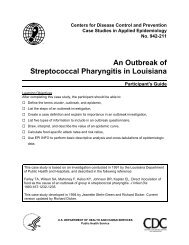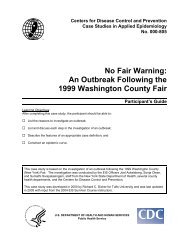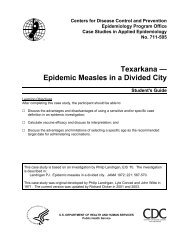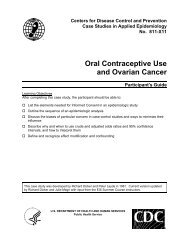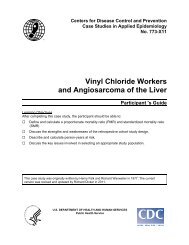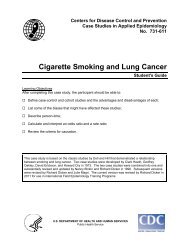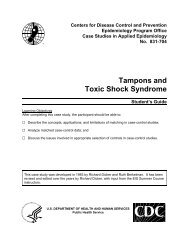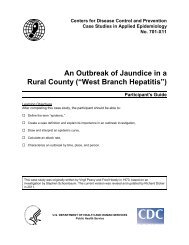case studies X\XUnknown Disease in SC\Xunkdis_sc ... - Library
case studies X\XUnknown Disease in SC\Xunkdis_sc ... - Library
case studies X\XUnknown Disease in SC\Xunkdis_sc ... - Library
You also want an ePaper? Increase the reach of your titles
YUMPU automatically turns print PDFs into web optimized ePapers that Google loves.
CDC / EIS Summer Course 2004: Epidemic <strong>Disease</strong> <strong>in</strong> S.C. - Student's Guide Page 2PART IOver a period of years, physicians <strong>in</strong> the ruralsoutheastern United States reported theoccurrence of a disease that had not beenrecognized previously. S<strong>in</strong>ce report<strong>in</strong>g wasrequired <strong>in</strong> only one state, and s<strong>in</strong>ce medicalservices were limited, record<strong>in</strong>g of the <strong>in</strong>cidenceof this disease was irregular.Although the disease <strong>in</strong> question was easilydiagnosed on cl<strong>in</strong>ical grounds, the etiology wasunknown at the time. Pathogenesis, mode ofspread, immunity, and the role of social andenvironmental factors were matters ofcontroversy. Many theories concern<strong>in</strong>g thenature of the disease were proposed.In an effort to determ<strong>in</strong>e the extent of thedisease, a questionnaire was mailed to allpractic<strong>in</strong>g physicians <strong>in</strong> eight states <strong>in</strong> theSoutheast regard<strong>in</strong>g the number of <strong>case</strong>s theyhad seen <strong>in</strong> the preced<strong>in</strong>g 5 years. Onlyone-fourth of the physicians responded. Theyreported an <strong>in</strong>crease from 622 to 7,017 <strong>case</strong>sover the 5-year <strong>in</strong>terval.The follow<strong>in</strong>g year, a U.S. Public Health Serviceepidemiologist was assigned to <strong>in</strong>vestigate theepidemic. After some prelim<strong>in</strong>ary observations,a field survey was conducted to determ<strong>in</strong>e theextent and the nature of the disease.Question 1:Into what general etiologic categories might one divide diseases that can occur <strong>in</strong>epidemic form?The survey was conducted <strong>in</strong> a five-countyregion <strong>in</strong> northwestern South Carol<strong>in</strong>a where thedisease was prevalent. The survey area<strong>in</strong>cluded 24 mill towns with populations from 500to 1,500. These villages varied widely <strong>in</strong> theirsanitary status. Some had public water supplies,some had sewage systems, some had both, andsome had neither. The survey focused onfamilies of a s<strong>in</strong>gle racial group.In each village, bi-weekly visits were made toeach household over a period of 1 year to lookfor <strong>case</strong>s. The name, age, sex, and maritalstatus of each member were recorded. Theoccurrence of the disease was determ<strong>in</strong>ed byhistory and exam<strong>in</strong>ation. Questionable <strong>case</strong>swere referred to one of the directors of the studywho had considerable experience <strong>in</strong> diagnos<strong>in</strong>gthe disease.Question 2:What categories of <strong>in</strong>formation would you want <strong>in</strong> order to de<strong>sc</strong>ribe the epidemic?




